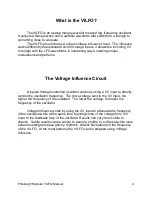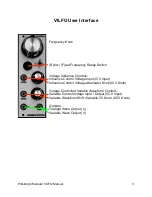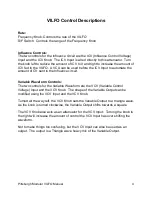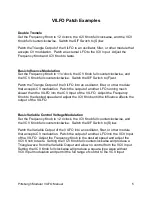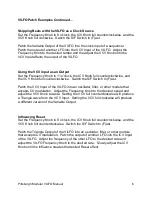
VILFO Patch Examples
Double Tremolo
Set the Frequency Knob to 12 o'clock, the ICV Knob full clockwise, and the VCV
Knob full counterclockwise. Switch the S/F Switch to (S)low.
Patch the Triangle Output of the VILFO to an oscillator, filter, or other module that
accepts CV modulation. Patch an external LFO to the ICV Input. Adjust the
Frequency Knob and ICV Knob to taste.
Basic Influence Modulation
Set the Frequency Knob to 11 o'clock, the ICV Knob full counterclockwise, and
the VCV Knob full counterclockwise. Switch the S/F Switch to (F)ast.
Patch the Triangle Output of the VILFO into an oscillator, filter, or other module
that accepts CV modulation. Patch the output of another LFO running much
slower than the VILFO into the ICV Input of the VILFO. Adjust the Frequency
Knob to the desired speed and adjust the ICV Knob until the Influence affects the
output of the VILFO.
Basic Variable Control Voltage Modulation
Set the Frequency Knob to 12 o'clock, the ICV Knob full counterclockwise, and
the VCV Knob full counterclockwise. Switch the S/F Switch to (S)low.
Patch the Variable Output of the VILFO into an oscillator, filter, or other module
that accepts CV modulation. Patch the output of another LFO into the VCV Input
of the VILFO. Adjust the Frequency Knob to the desired speed and adjust the
VCV Knob to taste. Setting the VCV Knob full counterclockwise will produce a
Triangle wave from the Variable Output and allow no control from the VCV Input.
Setting the VCV Knob full clockwise will produce a square-type wave without
VCV Input modulation and permit the full range of control to the VCV Input.
Pittsburgh Modular VILFO Manual
!
5


